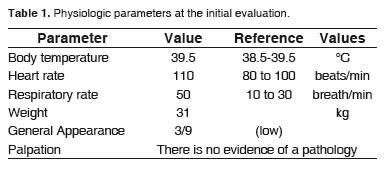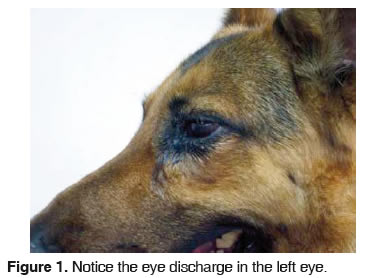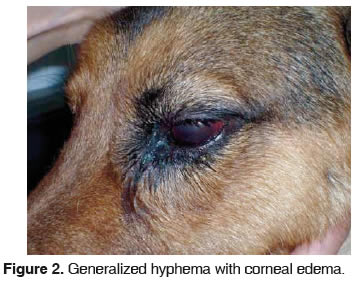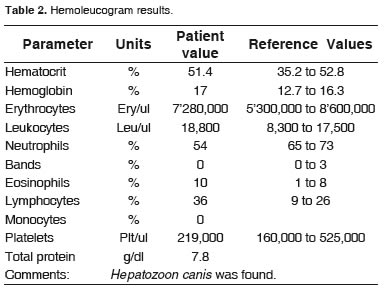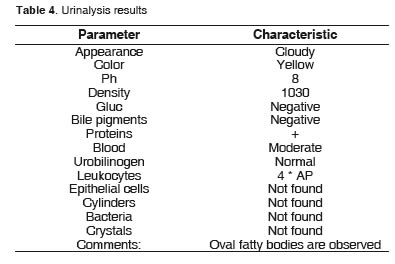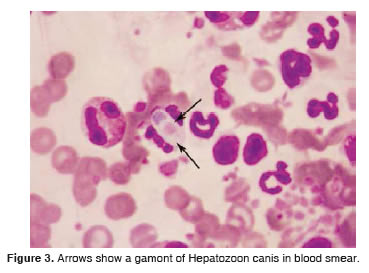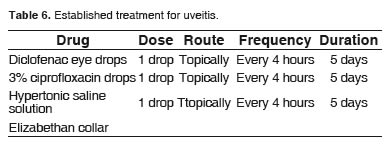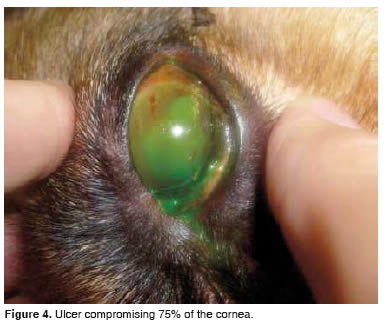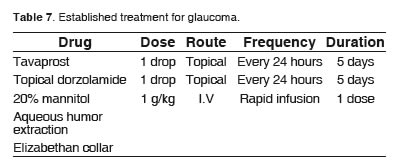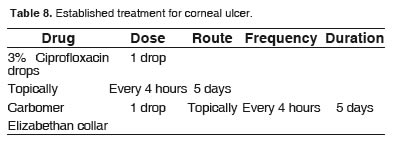Services on Demand
Journal
Article
Indicators
-
 Cited by SciELO
Cited by SciELO -
 Access statistics
Access statistics
Related links
-
 Cited by Google
Cited by Google -
 Similars in
SciELO
Similars in
SciELO -
 Similars in Google
Similars in Google
Share
Revista Colombiana de Ciencias Pecuarias
Print version ISSN 0120-0690On-line version ISSN 2256-2958
Rev Colom Cienc Pecua vol.23 no.4 Medellín Oct./Dec. 2010
Casos clínicos
Uveitis and glaucoma associated with Hepatozoon canis infection: a case report¤
Uveítis y glaucoma asociados a infección por Hepatozoon canis: reporte de un caso
Uveitis e glaucoma em um canino compatível com infecção por Hepatozoon canis: Reporte de um caso.
Sandra P Acevedo T1*, MV, Esp Medic; Mauricio Ramírez L2, MV, cEsp.Clin; Luis G Restrepo R3, MV, cEsp Medic;
1CENTAURO Research Group, Faculty of Agricultural Sciences, University of Antioquia, AA 1226, Medellín, Colombia.
2Student of Clinical specialization in small animal species, CENTAURO Research Group, Faculty of Agricultural Sciences, University of Antioquia, A.A. 1226, Medellin, Colombia. 3Student of Medical specialization in small animal species, CENTAURO Research Group, Faculty of Agricultural Sciences, University of Antioquia, A.A. 1226, Medellin, Colombia.
(Received: 3 march, 2009; accepted: 20 august, 2009)
Published in spanish: Rev Colomb Cienc Pecu 2009; 22:287-295
Summary
We report the case of a five years old German Shepherd dog, who presented anterior uveitis in his left eye which then led him to glaucoma and corneal ulcer. Clinical examination found a patient with low body condition, muscle weakness, dull and brittle coat, and unspecific symptomatology. During both the cell blood count (CBC) and blood smears, gamonts of Hepatozoon canis were found in blood and aqueous humor. Diagnosis, treatment and progress are reported.
Key words: glaucoma, Hepatozoon canis, Rhipicephalus sanguineus, uveítis.
Resumen
Se expone el caso de un perro Pastor Alemán de cinco años y medio de edad, el cual presentó uveítis anterior en ojo izquierdo que luego le condujo a glaucoma y úlcera corneal. En el examen clínico se encontró un paciente con baja condición corporal, debilidad muscular, además de un pelaje opaco y quebradizo, con sintomatología inespecífica. Tanto en el hemograma como en los extendidos sanguíneos se encontraron gamontes de Hepatozoon canis en sangre y humor acuoso. Se discute su diagnóstico, tratamiento y evolución.
Palabras clave: glaucoma, Hepatozoon canis, Rhipicephalus sanguineus, uveítis.
Resumo
Expõe-se um caso de um cão Pastor Alemão de cinco anos de idade, o qual apresentou uveitis anterior no olho esquerdo e que levou à presencia de um glaucoma e uma úlcera de córnea. No exame clínico encontrou-se um paciente com baixa condição corporal, debilidade muscular e pelagem opaca e quebradiça, com sintomatologia inespecífica. No hemograma e nos estendidos sanguíneos encontraramse gamontes de Hepatozoon canis no sangue e humor aquoso. Discute-se o seu diagnóstico, tratamento e evolução.
Palavras chave: glaucoma, Hepatozoon canis, Rhipicephalus sanguineus, uveitis.
¤ To cite this paper: Acevedo SP, Ramírez M, Restrepo LG. Uveitis and glaucoma associated with Hepatozoon canis infection: a case report. Rev Colom Cienc Pecu 2010; 23:485-491.
* Corresponding Author: Sandra Patricia Acevedo. Facultad de Ciencias Agrarias. Universidad de Antioquia. Carrera 75 No. 65-87. Ciudadela de Robledo. Medellín, Colombia. Tel: (574) 219 91 18. E-mail: crisalida18@hotmail.com
Introduction
Hepatozoonosis in dogs is a worldwide disease, mostly prevalent in rural areas. The condition is caused by a protozoan of the phylum Apicomplexa, genus Hepatozoon, species canis (Aguiar et al., 2004; Baneth et al., 2003; Stades et al., 1999). Besides the dog, this protozoan infects other mammals such as fox, coyote, jackal, hyena, and leopard (Mateus et al., 2007; Stades et al., 1999).
Hepatozoon canis is transmitted through ingestion of ticks of the genus Rhipicephalus sanguineus contaminated with mature oocysts of Hepatozoon canis. There is no reported evidence regarding the transmission through the saliva of the tick (Aguiar et al., 2004, Allen et al., 2008). In dogs, the disease is often asymptomatic but can cause varying degrees of granulomatous inflammation in various organs, mainly in the muscles, which leads to anorexia, weight loss, weakness, diarrhea and eye discharge (Allen et al., 2008, O'Dwyer et al., 2006; Eiras et al., 2007; Mundim et al., 2008).
In this paper we describe the case of a canine patient who presented anterior uveitis in the left eye, and later developed glaucoma. The dog had clinical signs of infection with symptoms associated with Hepatozoon canis, a hemoparasite which was isolated from the blood and aqueous humor of the patient.
Patient assessment
Review
Male German Shepherd dog, five years-old, weighing 31 kg, dewormed and vaccinated. During four years living in a farm located in the eastern region of Antioquia, Colombia.
Anamnesis
The owners took the patient for consultation when they noticed the dog had progressive vision loss in his left eye for about a week, along with purulent discharge and great pain. Gentamicin, dexamethasone and lidocaine-based eye drops were administered, but failed to improve the condition.
For several months he had lost weight, had a poor appetite, malaise and severe hair loss. A year ago, the patient had lost vision in his right eye after a trauma.
Findings on physical examination
Clinical evaluation found a fearful patient, with marked anxiety, hyperemic ocular and oral mucous membranes, panting (50 breaths per minute, bpm), strong pulse (110 beats per minute, bpm), 39.5 ºC body temperature, 2 seconds capillary refill time, dull coat, low body condition (3/9), and difficulty to walk and to recognize objects and his environment (Table 1).
Clinical neurological examination revealed no alterations. However, clinical ophthalmic examination found miotic pupil, a marked blepharospasm and eye pain, mucous-purulent secretion, corneal edema, chemosis and episcleritis (Figures 1 and 2). At the obstacles test, it hit everything and menace reflex showed negative.
Buphthalmos was diagnosed in a second examination of the eye, four days after the first one. Intraocular pressure (IOP) was 67 mm Hg, which is a greatly increased value, considering that reference values fluctuate between 15 to 20 mm Hg for the Schiotz tonometer, confirming the glaucoma diagnosis. Furthermore, widespread hyphema and surface ulcer on the 50% of cornea was found.
Diagnostic aids
Routine laboratory examinations were performed, such as hemogram (Table 2), creatinine, and ALT (Table 3), in addition to urinalysis (Table 4) to rule out a systemic disease which could be the cause of uveitis, including hypertension secondary to an acute renal failure, or vasculitis for blood parasites, such as Ehrlichia canis, bacteria such as Leptospira, or other parasites such as Onchocerca sp. The blood chemistry tests and urine analysis found no signs that might suggest some kind of alteration (Tables 1, 2 and 3). The hemogram showed a mild leukocytosislymphocytosis and moderate eosinophilia.
Three or more gamonts of Hepatozoon canis were found in every blood smear stained with Hemacolor (Figure 3), allowing us to relate the lesions observed with the parasite.
Treatment
At the time of consultation, while awaiting laboratory results, and given the severity of the lesions which could cause total blindness due to functional compromise of the other eye, an uveitis and corneal edema treatment was started based on topical NSAIDs (diclofenac sodium 1.0 mg drops), ophthalmic antibiotic (Ciprofloxacin 3.0 mg) and hypertonic saline 5% (Table 6) (Forlano et al., 2007; Rubini et al., 2006). Although there is no specific medical treatment for Hepatozoon canis (Aguiar et al., 2004, Mateus et al., 2007; Camacaro et al., 1997), once the lab results were received and the parasite identified, the patient was medicated with Imidocarb dipropionate (12%) and Trimethoprimsulfa 480 mg/5ml (Table 5), drugs commonly used in small animal medicine.
Five days after the initial treatment started, the patient showed an increase in intraocular pressure to 67 mmHg, with pain and evidence of a superficial corneal ulcer compromising 75% of the corneal surface, making it necessary to try a new therapy (Figure 4). An anti-glaucomatous therapy with mannitol (20%) was started (Herrera, 2007). Given the seriousness of the problem and the risk of suffering ptisis bulvi because of increased intraocular pressure, 0.4 ml of aqueous humor were extracted through the iridiocorneal angle, under general anesthesia with propofol (5 mg/kg) and Diazepam (0.4 mg/kg), using a 26 gauge needle. The extracted fluid presented a bloody aspect.
The cytological analysis of the sample also resulted in the presence of Hepatozoon canis gamonts. After the extraction, intraocular pressure was closer to normal (52 mm/hg), preventing the loss of eye function and reducing the pain. Treatment also included ranitidine (2 mg/kg), Ampicillin-sulbactam (30 mg/kg, iv) and Tramadol (1mg/kg).
It was recommended to continue the treatment described in Table 4, and medical treatment for glaucoma (Table 7) and corneal ulcer (Table 8) was also started. It was also recommended the use of an Elizabethan collar, and to stop administering both diclofenac drops and saline.
The patient was examined again 10 days later, finding that glaucoma had improved. He also showed a significant reduction of pain and intraocular pressure, but vision loss was evident, which redirected diagnosis towards a possible retinal and optic nerve degeneration that could affect up to 100% vision.
Owners were advised to hospitalize the patient and not to move him back to the farm in order to keep him under observation. Unfortunately, despite all the possible treatments offered to them, they decided to take him to another clinic for euthanasia, arguing they were not willing to continue with medical therapy for economic reasons and because the animal could not fulfill the purpose for which they were keeping him.
Discussion
Hepatozoonosis is a disease of difficult diagnosis (Johnson et al., 2008, Li et al., 2008; Swing et al., 2003) because the clinical signs are diverse and nonspecific, resulting in nausea, malaise, uveitis, headaches and even mild to severe lameness for no apparent reason (Ettinger et al., 2005). Routine laboratory examinations do not yield results that can guide to the diagnosis of the disease (Li et al., 2008).
The routine laboratory method for the diagnosis of this condition is through blood smears using peripheral blood to try to visualize the gamonts (Mateus et al., 2007). Nevertheless, it does not always work, because affected cells may be one or two per 1000 leukocytes (Aguiar et al., 2004; Matjila et al., 2008), which makes it extremely difficult to detect, generating many false negatives.
Because of this, the ideal diagnostic methods to confirm or exclude the disease include PCR, ELISA, indirect immunofluorescence or Western Blood (Aguiar et al., 2004, Mateus et al., 2007). But the high costs of such tests, combined with the unspecific signs, and the few reports of this condition, do not encourage their use in clinical practice (Matjila et al., 2008). In our case, there was no possibility of performing these tests, because our laboratories do not have the required equipment.
What facilitated the accurate diagnosis in our case, was the direct visualization of Hepatozoon canis gamonts. It would be virtually impossible to diagnose the condition without visualizing the parasites, unless the patient had a very high parasite load.
In the case described, the parasite load was quite high, since there were three or more gamonts in each blood smear, which is very unusual and facilitated the correct diagnosis. It is important to highlight here the need of qualified laboratory personnel to properly identify the agent, avoiding false negatives.
The aqueous humor extract containing the protozoan is a very uncommon finding. No reports on Hepatozoon canis located in canine eyes have been found. This is difficult to explain case. For any biotic or abiotic material to go through the ocular blood-aqueous barrier it is necessary to pass through active or passive diffusion. The barrier has 40 Å pores and the gamonts of Hepatozoon canis measure 11 μm x 4 μm in average (Baneth et al., 2003; Karagenc et al., 2006), which makes it impossible for the transit of protozoan under normal conditions.
According to Maggs et al. (2008), the uvea is an immunologically competent tissue. When ocular antigens are processed at distant sites, the sensitized lymphocytes migrate toward the antigen, enter the uvea and deal with the formation of antibodies or cell-mediated immune reactions. Repeated exposure to the same antigen results in a more rapid and potent response (anamnestic). This inflammation is evident because of the pain, vascular congestion and hyper-permeability. In summary the uvea acts as an accessory lymph node.
Autoimmune phenomena take place in the uvea. Any previous damage to the tissue (eg. a previous inflammation) releases specific uveal antigens normally located outside the patrol route of lymphocytes (intracellular location). These antigens promote an immune response in the uvea. It is possible that this is the mechanism participating in Canine recurrent uveitis, in which inflammatory stimulus may vary (eg, Leptospira sp., Onchocerca sp) (Maggs et al., 2008).
A parasitic infectious process, like the one brought in this case, causes an acute inflammation which necessarily alters the structure of vascular endothelium and thus the permeability of uveal blood vessels, promoting hemoparasite transit to the anterior chamber with the local anatomical and physiological consequences previously described (Herrera, 2007; Peiffer et al., 2002).
The anterior uveitis, initially manifested, produced glaucoma, since inflammation of the iris and ciliary bodies affected trabecular fibers, which together with the micro or particulate inflammatory exudates in the anterior chamber, sealed in the trabecular and ciliary cleft, favoring the accumulation of aqueous humor (Herrera, 2007).
Intraocular pressure is usually reduced during uveitis. The passage of aqueous humor can be mitigated by structural alterations that occur during uveitis, such as angle lock with inflammatory cells and debris, peripheral anterior synechia formation, cellular infiltration of the drainage angle, and pupillary blockage caused by occlusion of the pupil (Maggs et al. , 2008), resulting in glaucoma, secondary to anterior uveitis.
Several drugs have been used to treat hepatozoonosis. The most commonly used are trimethoprim sulfa and imidocarb dipropionate. Besides these, diminazene diaceturate, tetracyclines, primaquine phosphate, toltrazuril, clindamycin, or pyrimethamine in a combined therapy have been used with mixed results (Aguiar et al., 2004; Baneth et al., 2003; Mateus et al., 2007). In general, these drugs do not give the expected result because the complete removal of protozoa has not been achieved (Baneth et al., 2003).
In the case under discussion it was not possible to assess the patient's evolution, his response to the medical therapy, any changes in the number of gamonts, or the patient's recovery, given the owners premature decision to euthanize the patient. The autopsy would have been very helpful for understanding the pathology of the disease.
Conclusions
Hepatozoonosis is a difficult to diagnose disease. Any animal that is taken to consultation with uveitis and glaucoma should be suspected of being infected with Hepatozoon canis, especially if the patient has no eye compromise and other diseases compatible with the clinical signs presented have been ruled out.
Considering the complexity of diagnosing the disease, when the diagnostic tests outlined above cannot be conducted, the clinician should perform blood smears asking the clinical laboratory to look for possible parasites in the sample submitted.
Given the diversity of clinical signs and the diagnostic limitations that have been discussed, it is imperative that the medical and clinical laboratory have the sufficient knowledge about this disease, so that the clinician can have a proper approach to its diagnosis. Therefore, it is important to establish protocols to determine the prevalence and incidence of hepatozoonosis, which may be underdiagnosed.
Acknowledgements
The authors thank bacteriologist Clemencia Correa Restrepo from the Veterinary Clinical Laboratory, Faculty of Agricultural Sciences, University of Antioquia, for her assistance in the identification of the parasite, and to veterinarian Héctor A. Jiménez Arboleda, for reviewing and proofreading this paper.
Referencias
1. Aguiar DM, Ribeiro MG, Silva WB, Dias JG, Megid J, Megid AC. Hepatozoonose canina: achados clínico-epidemiológicos emtrês casos. Arq Bras Med Vet Zootec 2004; 56, suppl 3:411-413. [ Links ]
2. Allen KE, Li Y, Kaltenboeck B, Jonson EM, Reichard MV, Roger JP, Susan EL. Diversity of Hepatozoon species in naturally infected dogs in the southern United Status. Vet Parasitol 2008; 154:220-225. [ Links ]
3. Baneth G, Mathew JS, Shkap V, Macintire D K, Barta JR, Sidney AE. Swing. Canine hepatozoonosis: two disease syndromes caused by separate Hepatozoonspp. Trends Parasitol 2003; 19 suppl1:27-31. [ Links ]
4. Camacaro I, Pérez JR, Hernández R. Hepatozoonosis y erlichiosis en un perro. Informe de un caso. Vet Tropic 1997; 22 suppl 1:77-81. [ Links ]
5. Eiras DF, J Basabeb J, Scodellaro CF, Banach DB, Matos ML, Krimer A, Baneth G. First molecular characterization of canine hepatozoonosis in Argentina: evaluation of asymptomatic Hepatozooncanis infection in dogs from Buenos Aires. Vet Parasitol 2007; 149:275-279. [ Links ]
6. Ettinger SJ, Feldman CE (eds). Textbook of veterinary internal medicine. 6 ed. St. Louis: Saunders; 2005. [ Links ]
7. Forlano MD, Teixeira KRS, Scofield A, Elisei C, Yotoko KSC, Fernandes KR, Linhares GF, Ewing SA, Massard CL. Molecular characterization of Hepatozoonsp. from Brazilian dogs and its phylogenetic relationship with other Hepatozoonspp. Vet Parasitol 2007; 145:21-30. [ Links ]
8. Herrera DH. Oftalmología clínica en animales de compañía. 2nd ed. Buenos Aires. Editorial Inter-médica; 2007. [ Links ]
9. Jonson EM, Allen KE, Panciera RJ, Little SE, Swing SA. Infectivity of Hepatozoonamericanum cystozoites for a dog. Vet Parasitol 2008; 154:148-150. [ Links ]
10. Karagenc TI, Pasa S, Kirli G, Hosgor M, Bilgic HB, Ozon YH, Atasoy A, Eren H. A parasitological, molecular and serological survey of Hepatozoon canis infection in dogs around the Aegean coast of Turkey. Vet Parasitol 2006; 135:113-119. [ Links ]
11. Li Y, Wang C , Allen KE, Little SE, Ahluwalia SK, Gao D, Macintire DK, Blagburn DL, Kaltenboeck B. Diagnosis of canine Hepatozoon spp. infection by quantitative PCR. Vet Parasitol 2008; 157:50-58. [ Links ]
12. Maggs DJ, Miller PE, Ofri R. Slatter`s Fundamentals of Veterinary Opthalmology. 4 edición. St. Louis, Missouri. Ed. Saunders Elsevier; 2008. [ Links ]
13. Mateus A, Cala F, Vargas G, Arcila V, Castellanos V. Reporte de casos clínicos con Hepatozoon canis en el Centro Médico Quirúrgico Veterinario de la Universidad Cooperativa de Colombia. Rev electrónica Vet 2007; 8 suppl 5:1695-7504. [ Links ]
14. Matjila PT, Andrew L, Leisewitz, Jongejan F, Henk J, Penzhorn BL. Molecular detection of Babesia rossi and Hepatozoon sp. In African wild dogs (Lycaon pictus) in South Africa. Vet Parasitol 2008; 157:123-127. [ Links ]
15. Mundim AV, Morais IA, Tavares M, Cury MC, Mundim MJS. Clinical and hematological signs associated with dogs naturally infected by Hepatozoon sp. and with other hematozoa: A retrospective study in Uberla ndia, Minas Gerais, Brazil. Vet Parasitol 2008; 153:3-8 [ Links ]
16. O'Dwyer LH, Saito ME, Hasegawa MY, Kohayagawa A. Prevalence, hematology and serum biochemistry in stray dogs naturally infected by Hepatozoon canis in São Paulo. Arq Bras Med Vet Zootec 2006; 58 suppl 4:688- 690. [ Links ]
17. Peiffer RL, Petersen SM. Oftalmología de pequeños animales. 2nd ed. Madrid: Ediciones Harcourt; 2002. [ Links ]
18. Rubini AS, Paduan KS, Perez RR, Ribolla PEM, O'Dwyer LH. Molecular characterization of feline Hepatozoon species from Brazil. Vet Parasitol 2006; 137:168-171. [ Links ]
19. Stades FC, Boevé MH, Neumann W, Wyman M. Oftalmología para el veterinario práctico. 1ed. Buenos Aires. Editorial Intermedica; 1999. [ Links ]
20. Swing SA, Panciera RJ. American Canine Hepatozoonosis. Clin microbiol reviews 2003, 16 suppl 4:688-697.EscucharLeer fonéticamenteDiccionario - Ver diccionario detallado [ Links ]













